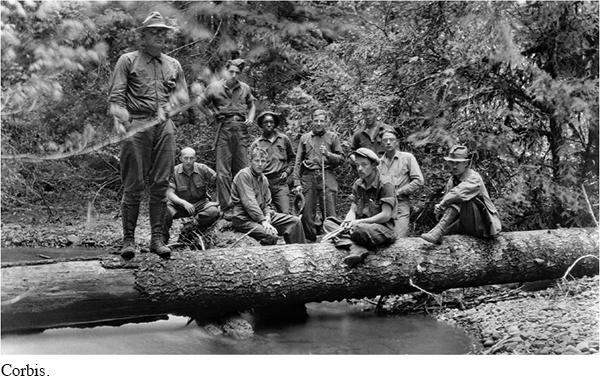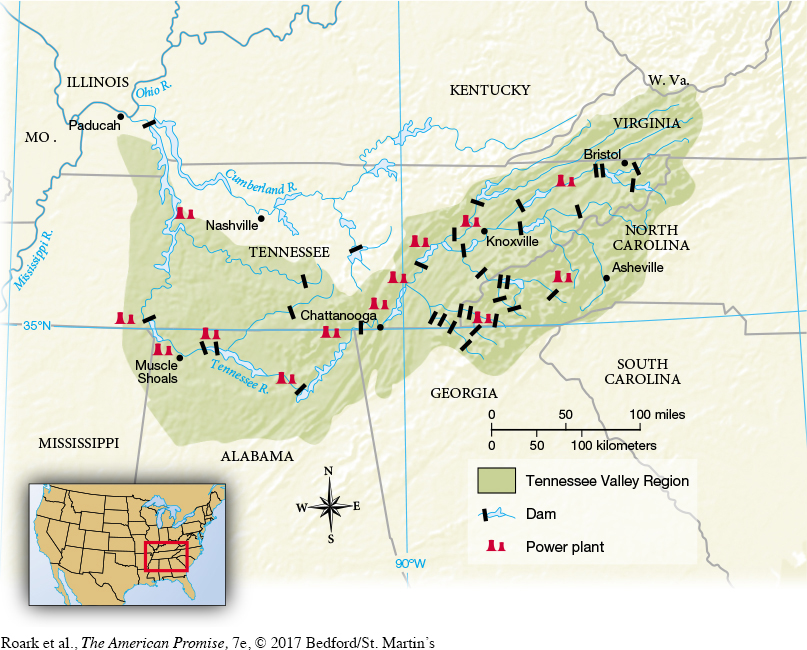The American Promise: Printed Page 687
The American Promise, Value Edition: Printed Page 627
The American Promise: A Concise History: Printed Page 714
Relief and Conservation Programs
Patching the nation’s financial structure provided little relief for the hungry and unemployed. A poor man from Nebraska asked Eleanor Roosevelt “if the folk who was borned here in America . . . are this Forgotten Man, the President had in mind, [and] if we are this Forgotten Man then we are still Forgotten.” The federal government had never assumed responsibility for needy people, except in moments of natural disaster or emergencies such as the Civil War. Instead, churches, private charities, county and municipal governments, and occasionally states assumed the burden of poor relief, usually with meager payments. The depression necessitated unprecedented federal relief efforts, according to New Dealers. As a New Yorker who still had a job wrote the government, “We work, ten hours a day for six days. In the grime and dirt of a nation [for] . . . low pay [making us] . . . slaves—
The Federal Emergency Relief Administration (FERA), established in May 1933, supported four million to five million households with $20 or $30 a month. FERA also created jobs for the unemployed on thousands of public works projects, organized into the Civil Works Administration (CWA), which put paychecks worth more than $800 million into the hands of previously jobless workers. Earning wages between 40 and 60 cents an hour, laborers renovated schools, dug sewers, and rebuilt roads and bridges.
The most popular work relief program was the Civilian Conservation Corps (CCC), established in March 1933. It offered unemployed young men a chance to earn wages while working to conserve natural resources, a long-

The New Deal’s most ambitious and controversial natural resources development project was the Tennessee Valley Authority (TVA), created in May 1933 to build dams along the Tennessee River to supply impoverished rural communities with cheap electricity (Map 24.3). The TVA set out to demonstrate that a partnership between the federal government and local residents could overcome the barriers of state governments and private enterprises to make efficient use of abundant natural resources and break the ancient cycle of poverty. The TVA improved the lives of millions in the region with electric power, flood protection, soil reclamation, and jobs, although it raised the hackles of many Americans who thought it trespassed unforgivably on free enterprise.
The American Promise: Printed Page 687
The American Promise, Value Edition: Printed Page 627
The American Promise: A Concise History: Printed Page 714
Page 688The American Promise: Printed Page 687
The American Promise, Value Edition: Printed Page 627
The American Promise: A Concise History: Printed Page 714
Page 689
New sources of hydroelectric power helped the New Deal bring the wonders of electricity to country folk, fulfilling an old progressive dream. When Roosevelt became president, 90 percent of rural Americans lacked electricity. Private electric companies refused to build transmission lines into the sparsely settled countryside when they had a profitable market in more accessible and densely populated urban areas. Beginning in 1935, the Rural Electrification Administration (REA) made low-